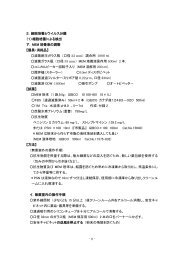Program and Abstracts(PDF)
Program and Abstracts(PDF)
Program and Abstracts(PDF)
You also want an ePaper? Increase the reach of your titles
YUMPU automatically turns print PDFs into web optimized ePapers that Google loves.
Presentation 19<br />
BIOINDICATOR AND BIOFILTER FUNCTION OF Ulva spp. IN FISH FARM<br />
ENVIRONMENTS<br />
Hisashi Yokoyama * , Yuka Ishihi<br />
National Research Institute of Aquaculture, Minamiise, Mie 516-0193, Japan<br />
* Email: hyoko at fra.affrc.go.jp<br />
In order to examine the efficiency of Ulva spp. (Chlorophyta) as a bioindicator <strong>and</strong> biofilter for<br />
dissolved inorganic nitrogen discharged from coastal fish farms, field surveys <strong>and</strong> field<br />
cultivation experiments were conducted in Gokasho Bay, central Japan. Naturally occurring<br />
green algae Ulva spp. were collected in <strong>and</strong> around a fish farm in February, May <strong>and</strong> July, <strong>and</strong><br />
their δ 15 N <strong>and</strong> tissue N contents were analyzed. Values of these parameters obtained in May <strong>and</strong><br />
July decreased with the distance from the fish cages, suggesting that Ulva spp. occurring in close<br />
vicinity to the fish farm assimilated the fish-excreted N. To evaluate this uptake, we housed<br />
round cut pieces of thalli of Ulva ohnoi in transparent chambers <strong>and</strong> cultured them beside a fish<br />
cage <strong>and</strong> at a control station for 2 wks in May, July <strong>and</strong> September. The thalli cultivated beside<br />
the fish cage showed significantly higher specific growth rates (15.8–20.9%) <strong>and</strong> higher N<br />
assimilation rates (4.2–13.9 mg N g dry wt –1 d –1 ), which are among the highest levels known for<br />
seaweed biofilters. The high growth rates during the warm season <strong>and</strong> easy cultivation indicate<br />
the suitability of Ulva ohnoi as a biofilter.<br />
ANNOTATED BIBLIOGRAPHY OF KEY WORKS<br />
Hirata, H., S. Yamasaki, H. Maenosono, T. Nakazono, T. Yamauchi, <strong>and</strong> M. Matsuda. 1994.<br />
Relative budgets of pO 2 <strong>and</strong> pCO 2 in cage polycultured red sea bream, Pagrus major <strong>and</strong> sterile<br />
Ulva sp. Suisanzoshoku, Vol:42. Pp 377–381.<br />
Polyculture of fish <strong>and</strong> seaweeds is a beneficial system in aquaculture. In spite of its importance<br />
from the ecological point of view. Little attention has been given in polyculture system. This may<br />
be due to the fact that fish <strong>and</strong> seaweeds have different growth seasons: fish grow in summer <strong>and</strong><br />
autumn while seaweeds propagate in winter <strong>and</strong> spring. Previously, culture methods for sterile<br />
Ulva sp., which grow in summer as do fish was reported. Following those methods, in the present<br />
study interrelation between pO 2 <strong>and</strong> pCO 2 in polyculture cages of red sea bream, Pagrus major<br />
<strong>and</strong> Ulva sp. at the fish culture farm of Azuma-cho Fish Seedling Center was investigated. Two<br />
cages, 7 m X 7 m X 7 m, each containing 1750 three years old fish weighting about 654 g were<br />
used in this experiment. pO 2 <strong>and</strong> pCO 2 were measured by Radiometer ABL-330. Considering the<br />
value of pO 2 in the control cage as 100%, pO 2 in the experimental cage st<strong>and</strong> 109.1%. On the<br />
other h<strong>and</strong>, average pCO 2 in the control cage as 100%, pCO 2 in the experiment cage st<strong>and</strong>s<br />
96.1%. From the results mentioned above, it may concluded that the pCO 2 in the experimental<br />
cage decreased to 4% while pO 2 augmented up to 9% compared to those in the control cage.<br />
36



